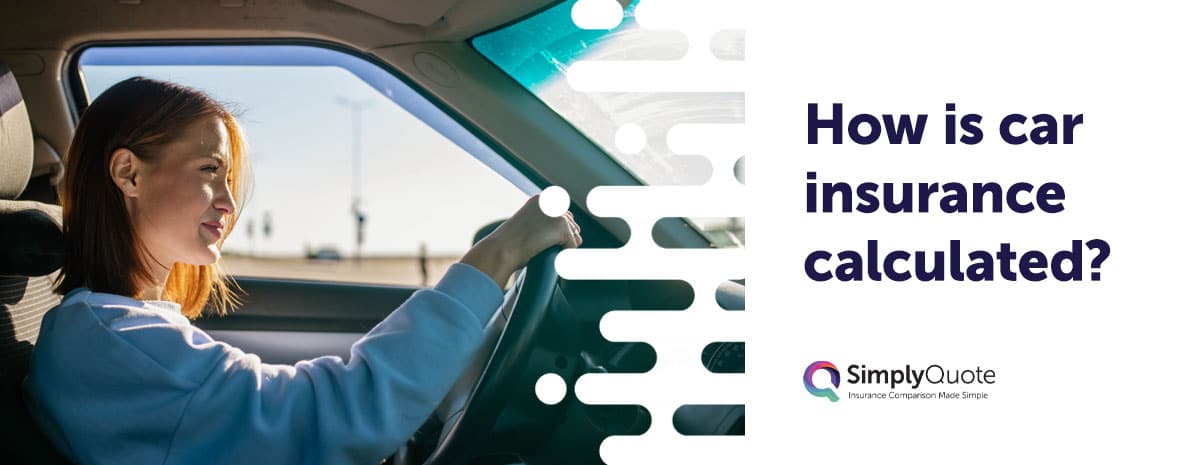How is car insurance calculated?
Car insurance is calculated based on factors such as your age, driving history, vehicle type, location, and annual mileage. Insurers use risk assessment models, claims data, and underwriting algorithms to determine the likelihood of a claim and set your premium accordingly.
Insurance companies analyse multiple data points to calculate risk. Your policy cost depends on how statistically likely you are to make a claim, with high-risk drivers paying more.
This guide explains the key factors affecting pricing and how you can lower your premium.

Looking to compare car insurance? Get your quote today!
Get QuotesHow do insurance companies calculate risk?
Insurers calculate risk by analysing statistical data, previous claims, and external databases to assess the likelihood of a driver making a claim.
High-risk drivers are charged higher premiums, while low-risk drivers may receive discounts.
Key risk assessment methods
Insurance companies use several data-driven techniques to evaluate risk:
- Actuarial Data Analysis – Insurers analyse large datasets of past claims to predict risk for specific driver profiles.
- Claims History – A history of accidents or previous claims increases risk, leading to higher premiums.
- External Databases – Insurers check records such as the Motor Insurance Database (MID) and Claims and Underwriting Exchange (CUE) to verify a driver’s insurance history.
- Credit Scoring – Some insurers assess credit history to determine financial reliability and potential risk.
- Vehicle Risk Classification – Insurers use the Group Rating Panel’s car insurance groups (1–50) to estimate repair costs and theft risks.
- Driving Behaviour (for Telematics Policies) – Black box insurance records acceleration, braking, and speed patterns to adjust pricing.
Why do different insurers quote different prices?
Car insurance quotes vary because each insurer uses different risk models, underwriting criteria, and pricing strategies.
Factors such as claims history, target customer demographics, and operational costs all influence the final premium.
Key reasons for price differences
- Different Risk Models – Each insurer assesses risk differently, meaning the same driver may be categorised as high-risk by one provider and low-risk by another.
- Underwriting Policies – Some insurers specialise in certain drivers, such as young or high-risk drivers, and price accordingly.
- Market Competition – Insurers adjust prices based on market demand, promotional offers, and competitor pricing.
- Claims Data & Payout Rates – Providers with higher claim payouts may charge more to cover costs.
- Operational Expenses – Companies with higher admin costs may set premiums higher to maintain profitability.
- Discounts & Incentives – Some insurers offer introductory discounts or bundle deals that temporarily lower costs.
What can you do to reduce your car insurance costs?
You can lower your car insurance costs by increasing your voluntary excess, maintaining a no-claims discount, choosing a lower-risk vehicle, and comparing quotes from multiple insurers.
Installing security devices and considering telematics policies can also reduce premiums.
Practical ways to reduce premiums
- Increase Voluntary Excess – Opting for a higher voluntary excess reduces the premium, but be sure you can afford it if you need to claim.
- Maintain a No-Claims Discount – Avoiding claims helps build a discount, which can lower premiums by up to 60% over time.
- Compare Quotes Regularly – Shopping around ensures you get the best deal, as insurers adjust rates frequently.
- Consider Telematics (Black Box) Insurance – If you’re a safe driver, telematics policies can offer significant savings.
- Choose a Lower-Risk Car – High-performance and modified cars cost more to insure, while smaller, less powerful cars are cheaper.
- Improve Security – Adding alarms, immobilisers, or parking in a secure location can lower your premium.
- Limit Annual Mileage – Insurers may offer lower premiums for lower mileage drivers.
How do telematics (black box insurance) affect pricing?
Telematics, or black box insurance, tracks driving behaviour using GPS and sensors to personalise premiums. Safe drivers can benefit from lower costs, while risky driving may increase insurance prices.
How telematics affects premiums
- Monitors Driving Behaviour – Insurers assess speed, acceleration, braking, and cornering to calculate risk.
- Rewards Safe Drivers – Careful driving leads to discounts, with potential savings of up to 30%.
- Penalises Risky Driving – Harsh braking, rapid acceleration, or driving at high-risk times (e.g., late at night) may result in higher premiums.
- Mileage Tracking – Policies often include mileage limits, with lower mileage drivers benefiting from reduced costs.
- Encourages Better Habits – Drivers become more conscious of their driving style, potentially improving road safety.
Why is car insurance more expensive for young drivers?
Car insurance is more expensive for young drivers because they are statistically more likely to be involved in accidents. Insurers calculate risk based on claims data, and younger drivers, especially those under 25, have a higher accident rate than older, more experienced drivers.
Key reasons for higher premiums
- Higher Accident Rates – Data shows that drivers aged 17-24 are more likely to be involved in crashes, leading to increased claims.
- Limited Driving Experience – Inexperienced drivers are at greater risk due to a lack of road awareness and hazard perception skills.
- Increased Claim Frequency – Younger drivers are more likely to make claims, which raises costs across the age group.
- Risky Driving Behaviour – Statistics indicate that young drivers are more prone to speeding and reckless driving.
- Vehicle Choice – Many young drivers opt for high-performance or modified vehicles, which can further increase premiums.
How young drivers can reduce premiums
- Choose a Lower Insurance Group Car – Smaller, less powerful cars are cheaper to insure.
- Consider Telematics Insurance – A black box policy rewards safe driving with lower premiums.
- Add an Experienced Named Driver – Listing a parent or guardian with a good record can reduce costs.
- Build a No-Claims Discount – Avoiding claims can lead to significant long-term savings.
Related Read: How much does young drivers insurance cost in the UK?
Final thoughts
Car insurance premiums are determined by multiple factors, including driver history, vehicle type, location, and insurer-specific risk assessments. Understanding how these elements impact pricing can help you make informed decisions and find ways to lower your costs.
While insurers use complex algorithms to assess risk, policyholders can take proactive steps to reduce premiums. Maintaining a no-claims discount, choosing a lower-risk vehicle, and considering telematics insurance are all effective strategies. Comparing quotes regularly ensures that you are not overpaying.
For younger drivers and those with modified cars, premiums can be higher due to increased risk. However, insurers offer incentives for safe driving, security upgrades, and limited mileage, all of which can contribute to cost savings.
By understanding how insurers calculate premiums, drivers can take control of their costs and secure the most competitive rates available.
Frequently Asked Questions (FAQs)
Yes, your job title and occupation can impact your insurance costs. Certain professions, such as delivery drivers or tradespeople, may have higher premiums due to increased mileage or vehicle usage.
Yes, parking on a secure driveway or in a garage usually lowers your premium, while parking on the street, especially in high-crime areas, can increase costs due to a higher theft risk.
It can. Adding an experienced, low-risk driver (such as a parent) to your policy may reduce costs, but adding a high-risk driver can increase premiums.
Unlike in the US, credit scores generally do not directly impact UK car insurance premiums. However, insurers may run credit checks if you choose to pay monthly, as this is considered a form of credit agreement.
Paying annually is usually cheaper, as monthly payments often include interest or additional admin fees. If you can afford it, paying upfront reduces overall costs.
Yes, insurers can access your DVLA record to verify your licence status, penalty points, and disqualifications. Providing incorrect details can lead to invalidated policies.
Many UK policies offer basic third-party cover for driving in the EU, but comprehensive cover may require an upgrade. Always check with your insurer before travelling.
Cars are categorised into insurance groups (1-50) based on factors like repair costs, performance, and security features. Lower group numbers generally mean cheaper premiums.
